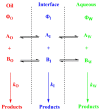Biochemistry of Antioxidants: Mechanisms and Pharmaceutical Applications
- PMID: 36551806
- PMCID: PMC9776363
- DOI: 10.3390/biomedicines10123051
Biochemistry of Antioxidants: Mechanisms and Pharmaceutical Applications
Abstract
Natural antioxidants from fruits and vegetables, meats, eggs and fish protect cells from the damage caused by free radicals. They are widely used to reduce food loss and waste, minimizing lipid oxidation, as well as for their effects on health through pharmaceutical preparations. In fact, the use of natural antioxidants is among the main efforts made to relieve the pressure on natural resources and to move towards more sustainable food and pharmaceutical systems. Alternative food waste management approaches include the valorization of by-products as a source of phenolic compounds for functional food formulations. In this review, we will deal with the chemistry of antioxidants, including their molecular structures and reaction mechanisms. The biochemical aspects will also be reviewed, including the effects of acidity and temperature on their partitioning in binary and multiphasic systems. The poor bioavailability of antioxidants remains a huge constraint for clinical applications, and we will briefly describe some delivery systems that provide for enhanced pharmacological action of antioxidants via drug targeting and increased bioavailability. The pharmacological activity of antioxidants can be improved by designing nanotechnology-based formulations, and recent nanoformulations include nanoparticles, polymeric micelles, liposomes/proliposomes, phytosomes and solid lipid nanoparticles, all showing promising outcomes in improving the efficiency and bioavailability of antioxidants. Finally, an overview of the pharmacological effects, therapeutic properties and future choice of antioxidants will be incorporated.
Keywords: antioxidants; bioactivity; bioavailability; nano antioxidants delivery systems; oxidative stress.
Conflict of interest statement
The authors declare no conflict of interest.
Figures
















Similar articles
-
Functional Ingredients from Agri-Food Waste: Effect of Inclusion Thereof on Phenolic Compound Content and Bioaccessibility in Bakery Products.Antioxidants (Basel). 2020 Dec 2;9(12):1216. doi: 10.3390/antiox9121216. Antioxidants (Basel). 2020. PMID: 33276525 Free PMC article. Review.
-
Pharmaceutical Formulations with P-Glycoprotein Inhibitory Effect as Promising Approaches for Enhancing Oral Drug Absorption and Bioavailability.Pharmaceutics. 2021 Jul 20;13(7):1103. doi: 10.3390/pharmaceutics13071103. Pharmaceutics. 2021. PMID: 34371794 Free PMC article. Review.
-
Oral bioavailability: issues and solutions via nanoformulations.Clin Pharmacokinet. 2015 Apr;54(4):325-57. doi: 10.1007/s40262-015-0242-x. Clin Pharmacokinet. 2015. PMID: 25666353 Review.
-
Naringenin Nano-Delivery Systems and Their Therapeutic Applications.Pharmaceutics. 2021 Feb 23;13(2):291. doi: 10.3390/pharmaceutics13020291. Pharmaceutics. 2021. PMID: 33672366 Free PMC article. Review.
-
Nano-Formulations of Natural Antioxidants for the Treatment of Liver Cancer.Biomolecules. 2024 Aug 19;14(8):1031. doi: 10.3390/biom14081031. Biomolecules. 2024. PMID: 39199418 Free PMC article. Review.
Cited by
-
Redox Homeostasis and Molecular Biomarkers in Precision Therapy for Cardiovascular Diseases.Antioxidants (Basel). 2024 Sep 25;13(10):1163. doi: 10.3390/antiox13101163. Antioxidants (Basel). 2024. PMID: 39456418 Free PMC article. Review.
-
Unveiling the link: exploring muscle oxygen saturation in fibromyalgia and its implications for symptomatology and therapeutic strategies.Med Gas Res. 2025 Mar 1;15(1):58-72. doi: 10.4103/mgr.MEDGASRES-D-24-00013. Epub 2024 Apr 21. Med Gas Res. 2025. PMID: 39436169 Free PMC article. Review.
-
Exploring the Potential of Halotolerant Actinomycetes from Rann of Kutch, India: A Study on the Synthesis, Characterization, and Biomedical Applications of Silver Nanoparticles.Pharmaceuticals (Basel). 2024 Jun 6;17(6):743. doi: 10.3390/ph17060743. Pharmaceuticals (Basel). 2024. PMID: 38931410 Free PMC article.
-
Innovative Delivery and Release Systems for Antioxidants and Other Active Substances in the Treatment of Cancer.Pharmaceuticals (Basel). 2023 Jul 21;16(7):1038. doi: 10.3390/ph16071038. Pharmaceuticals (Basel). 2023. PMID: 37513948 Free PMC article. Review.
-
The Biochemistry and Effectiveness of Antioxidants in Food, Fruits, and Marine Algae.Antioxidants (Basel). 2023 Apr 2;12(4):860. doi: 10.3390/antiox12040860. Antioxidants (Basel). 2023. PMID: 37107235 Free PMC article. Review.
References
-
- Rudrapal M., Khairnar S.J., Khan J., Bin Dukhyil A., Ansari M.A., Alomary M.N., Alshabrmi F.M., Palai S., Deb P.K., Devi R. Dietary Polyphenols and Their Role in Oxidative Stress-Induced Human Diseases: Insights into Protective Effects, Antioxidant Potentials and Mechanism(s) of Action. Front. Pharmacol. 2022;13:806470. doi: 10.3389/fphar.2022.806470. - DOI - PMC - PubMed
-
- Adwas A.A., Elsayed A., Azab A.E., Quwaydir F.A. Oxidative stress and antioxidant mechanisms in human body. J. Appl. Biotechnol. Bioeng. 2019;6:43–47. doi: 10.15406/jabb.2019.06.00173. - DOI
Publication types
LinkOut - more resources
Full Text Sources
Other Literature Sources

